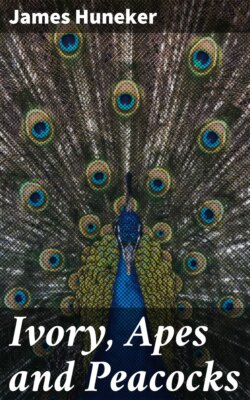Читать книгу Ivory, Apes and Peacocks - James Huneker - Страница 11
На сайте Литреса книга снята с продажи.
II
ОглавлениеHe seems to have been of an umbrageous character. His life was sad and simple. He was born August 20, 1860, at Montevideo—"Ville en amphithéâtre, toits en terrasses, rues en daumiers, rade enorme"—of Breton parentage. He died at Paris, 1887. Gustave Kahn, the symbolist poet, describes Laforgue in his Symbolistes and Décadents as a serious young man, with sober English manners and an extreme rectitude in the matter of clothes. Not the metaphysical Narcissus that was once Maurice Barrès—whose early books show the influence of Laforgue. He adored the philosophy of the Unconscious as set forth by Von Hartmann, was erudite, collected delicate art, thought much, read widely, and was an ardent advocate of the Impressionistic painters. I have a pamphlet by Médéric Dufour, entitled Etude sur l'Æthétique de Jules Laforgue: une Philosophie de l'Impressionisme, which is interesting, though far from conclusive, being an attack on the determinism of Taine, and a defence of Monet, Pissarro, and Sisley. But then we only formulate our preferences into laws. The best thing in it is the phrase: "There are no types, there is only humanity," to the wisdom of which we must heartily subscribe. From 1880 to 1886 Laforgue was reader to the Empress Augusta at Berlin and was admired by the cultivated court circle, as his letters to his sister and M. Ephrussi, his friend, testify. He was much at home in Germany and there is no denying the influence of Teutonic thought and spirit on his susceptible nature. Naturally prone to pessimism (he has called himself a "mystic pessimist") as was Amiel, the study of Hegel, Schopenhauer, and Hartmann solidified the sentiment. He met an English girl, Leah Lee, by name, and after giving her lessons in French, fell in love, and in 1887 married her. It is interesting to observe the sinister dandy in private life, as a tender lover, a loving brother. This spiritual dichotomy is not absent in his poetry. He holds back nothing in his self-revelations, except the sad side, though there is always an exquisite tremulous sensibility in his baffling art. A few months after his marriage he was attacked by the fatal malady, as was his unfortunate wife, and he was buried on his twenty-seventh birthday. Gustave Kahn notes that few followed him to the grave. He was unknown except to some choice spirits, the dozen superior persons of Huysmans, scattered throughout the universe. His wife survived him only a short time. Little has been written of him, the most complete estimate being that of Camille Mauclair, with an introduction by Maeterlinck—who calls his Hamlet more Hamlet than Shakespeare's. In addition to these, and Dufour, Kahn, De Gourmont and Felix Féneon, we have in English essays by George Moore, Arthur Symons, Philip Hale, the critic of music, and Aline Gorren. Mr. Moore introduced Laforgue in company with Rimbaud to the English reading world and Mr. Symons devoted to him one of his sensitive studies in The Symbolist Movement in Literature. Mr. Hale did the same years ago for American readers in a sympathetic article, The Fantastical Jules Laforgue. He also translated with astonishing fidelity to the letter and spirit of the author, his incomparable Lohengrin, Fils de Parsifal. I regret having it no longer in my possession so that I might quote from its delicious prose. As to the verse, I know of few attempts to translate the untranslatable. Perhaps Mr. Symons has tried his accomplished hand at the task. How render the sumptuous assonance and solemn rhythms of Marche Funèbre: O convoi solennel des soleils magnifiques?
